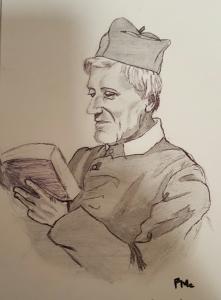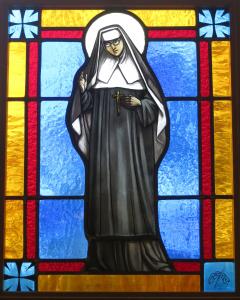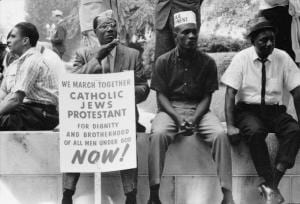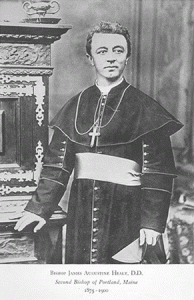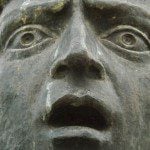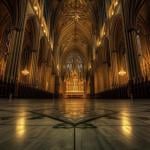Father John Moore, C.M, was President of St. John’s University, Brooklyn, from 1906 to 1925. He is seated in the front row center wearing the biretta. With him is the ordination class of 1912 from St. John’s Seminary. Standing fifth from the left in the back row is Bernard J. Quinn (1888-1940), whose canonization cause is currently under consideration.
LIFE IN A SEMINARY.
How a Catholic Priest is Trained for His Duties.
The Long and Severe Course of Discipline and Study.
A Day’s Routine Hard Work.
Work and Small Pay.
The Brooklyn Eagle, October 19, 1890
The celebration of the jubilee of the sacerdotal ordination of Bishop Loughlin and the fact that the new diocesan seminary, at Lewis avenue and Hart street, forms the material of the general jubilee gift, makes something about the training of the Catholic priest of present interest.
Life in a seminary is divided between study and the cultivation of piety and devotion to the sacred calling to which the students aspire. The rules of discipline are strict and are carefully enforced. A student rises at 5 o’clock in summer and 5:30 in winter. Prayer, meditation and attendance at mass take up the time until 7:30, when breakfast comes. There is a short recreation then before the first class lecture at 8:15. This with study fills an hour and a half. Then fifteen minutes free time and from 11 to 11:45 the class room again. Fifteen minutes prayer and examination of conscience comes before the noon dinner hour and after it recreation until 2 o’clock. Sacred reading for half an hour follows with forty-five minutes’ preparation for the next lecture. A quarter of an hour is given to recreation before the third lecture, which lasts until 4:15. A brief rest and an hour and a half in study and fifteen minutes in prayer filled up the time to the supper hour, 7 o’clock, followed by another recreation. At 9 o’clock prayers are said, and at 9:30 all lights must be out and everybody in bed. This is the average daily routine.
Silence is required all day, except during the four hours of recreation. No one is allowed outside the seminary grounds, except by special permission. Smoking is not permitted; neither is visiting in each others’ rooms allowed. Any violation of the rules is punished by withholding ordination for six months longer and continued infractions of the regulations merits expulsion from the seminary. This severe regimen is considered necessary in order that strict compliance with the trivial details of perfect discipline may bring about the self control and equipoise required in those who have a true vocation to the priesthood. Every seminarian keeps his own room in order, making his bed and all the rest.
All the lectures, except those in sacred eloquence and physical sciences, are given in Latin. It is the language of the house. During the first two years of his course the seminarian reads an advanced course of mental philosophy and ethics. He also studies Jewish antiquities, the history of the different systems of philosophy, the physical sciences, especially their bearing on revelation, the exegesis of the Old Testament, ecclesiastical and natural theology and some modern language. In the next four years the course embraces moral and dogmatic theology, sacred scripture, exegesis, hermeneutics and history, liturgy, canon law, sacred eloquence, plain chant and Hebrew.
At the end of two years, if the student shows the necessary disposition and qualification, he receives tonsure. The head, however, is no longer shaved, except in some of the regular orders. For secular priests the bishop now merely clips the hair in five places: in the front, back and crown and over each year, according to the modified form. The other minor orders are usually conferred at intervals of six months after this and are considered as steps leading to the last grand result— sacerdotal ordination. A summer vacation of several weeks is given, during which the students generally return to their homes, where they are supposed to be under the immediate supervision of their parish priests.
When he has finished his course at the seminary the candidate is again examined on his theological acquirements, and if he passes satisfactorily he is ordained a priest by the bishop. He cannot be made a priest, however, until he has received the other orders in regular course, and two grades of sacred orders cannot be conferred on the same day. The church teaches that a priest receives supernatural power in his ordination, an indelible character, and, if rightly disposed, grace to support him in the exercise of his ministry. Having received ordination he returns to his bishop, to whom he makes a vow of obedience as his spiritual superior, and is then assigned to work in some parish.
NOTE: St. John the Baptist Seminary officially opened in 1891 in Brooklyn’s Bedford-Stuyvesant section and remained in existence until 1932. During these years over four hundred alumni were ordained priests for the Brooklyn diocese under Vincentian direction. As Vincentian historian Father Stafford Poole notes, over time it “eventually proved to be too small” to accommodate the growing number of vocations. By 1927, the diocese had 250 candidates for the priesthood, of which St. John’s could only house seventy. Its place was taken by the Seminary of the Immaculate Conception, which officially opened at Huntington, Long Island, in 1930.
Located adjacent to the seminary were St. John the Baptist Church, which The Brooklyn Eagle called “one of the finest specimens of Roman architecture in this country”; St. John the Baptist Parochial School; St. John’s Preparatory School, widely regarded in its day as one of the city’s finest high schools for boys; St. John’s University, and a Vincentian residence, which at its height housed nearly ninety priests and brothers.
Theoretically, a young man in the neighborhood could be baptized in the church, receive all his sacraments there, attend grammar school through college, study for the priesthood, and be ordained in the parish church, all without ever leaving the block. For many years priests of the Brooklyn diocese were ordained at St. John the Baptist rather than St. James Cathedral, which could only accommodate a certain number of people.


